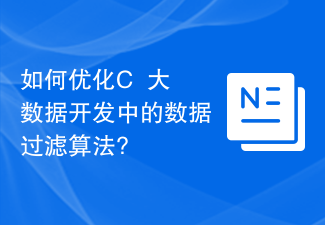PHP数据过滤:防止用户注入恶意代码
在网站开发中,用户输入的数据对于安全性来说是一个非常重要的问题。其中,防止恶意代码的注入是开发者需要特别关注的一点。本文将介绍一些常用的PHP数据过滤方法,帮助开发者在处理用户输入数据时提高安全性。
- HTML转义
HTML转义是一种简单而有效的方法,可以防止恶意代码的注入。当用户输入的数据需要在网页中展示时,必须对其进行HTML转义。PHP中提供了htmlspecialchars()函数来实现这一功能,它将特殊字符转换为HTML实体。
示例代码:
$userInput = "<script>alert('XSS Attack');</script>";
$filteredInput = htmlspecialchars($userInput);
echo $filteredInput;输出:
<script>alert('XSS Attack');</script>
- SQL过滤
在用户输入数据用于构建数据库查询语句时,必须进行SQL过滤以防止SQL注入攻击。最简单的方法是使用PHP内置的mysqli_real_escape_string()函数,对用户输入的字符串中的特殊字符进行转义。
示例代码:
$userInput = "admin' OR '1'='1"; $filteredInput = mysqli_real_escape_string($conn, $userInput); $query = "SELECT * FROM users WHERE username='$filteredInput'";
这样就可以防止用户输入导致的SQL注入攻击。
- 文件路径过滤
当用户提供的数据用于构建文件路径时,要确保用户输入的数据不包含恶意代码。可以使用PHP的realpath()函数来过滤用户输入的文件路径,确保最终的路径在安全的范围内。
示例代码:
$userInput = "../secret/passwords.txt";
$filteredInput = realpath($userInput);
if(strpos($filteredInput, "/var/www/html/") === 0) {
$filePath = $filteredInput;
// 继续处理文件操作
} else {
die("Invalid file path");
}这样可以防止用户通过提供恶意文件路径来访问系统中的文件。
- 输入验证
输入验证是防止用户注入恶意代码的重要手段之一。在接收到用户输入数据后,开发者应该对数据进行验证,确保其格式和内容符合预期。可以使用正则表达式或内置的过滤函数进行验证。
示例代码:
$userInput = "admin@example.com";
if(filter_var($userInput, FILTER_VALIDATE_EMAIL)) {
// 邮箱格式正确,继续处理
} else {
die("Invalid email address");
}这样可以确保用户输入的邮箱地址符合正确的格式。
- 参数绑定
在使用数据库查询时,应该优先考虑使用参数绑定的方式,而不是直接拼接用户输入的数据。参数绑定可以防止SQL注入攻击,并提高查询性能。
示例代码:
$stmt = $conn->prepare("SELECT * FROM users WHERE username = ?");
$stmt->bindParam(1, $userInput, PDO::PARAM_STR);
$stmt->execute();这样可以确保用户输入的数据被正确地绑定到SQL查询语句中。
总结:
在网站开发中,防止恶意代码的注入是一个不容忽视的安全问题。通过进行HTML转义、SQL过滤、文件路径过滤、输入验证和参数绑定等数据过滤方法,可以有效地提高网站的安全性,保护用户数据的安全。开发者应该充分认识到这个问题,并将数据过滤作为开发流程中的重要环节。只有做好数据过滤工作,才能保证网站的安全性和用户的信任度。
The above is the detailed content of PHP data filtering: Prevent users from injecting malicious code. For more information, please follow other related articles on the PHP Chinese website!
 PHP数据过滤:如何处理并防范错误输入Jul 29, 2023 am 10:03 AM
PHP数据过滤:如何处理并防范错误输入Jul 29, 2023 am 10:03 AMPHP数据过滤:如何处理并防范错误输入在开发Web应用程序中,用户的输入数据是无法可靠的,因此数据的过滤和验证是非常重要的。PHP提供了一些函数和方法来帮助我们处理和防范错误输入,本文将讨论一些常见的数据过滤技术,并提供示例代码。字符串过滤在用户输入中,我们经常会遇到那些包含HTML标签、特殊字符或者恶意代码的字符串。为了防止安全漏洞和脚本注入攻
 VUE3基础教程:使用filters进行数据过滤Jun 15, 2023 pm 08:37 PM
VUE3基础教程:使用filters进行数据过滤Jun 15, 2023 pm 08:37 PMVUE3是目前前端开发中较为流行的一种框架,其所提供的基础功能能够极大的提高前端开发效率。其中filters就是VUE3中一个非常有用的工具,使用filters可以很方便地对数据进行筛选、过滤和处理。那么什么是filters呢?简单来说,filters就是VUE3中的过滤器。它们可以用于处理被渲染的数据,以便在页面中呈现出更加理想的结果。filters是一些
 Excel数据导入Mysql常见问题汇总:如何处理导入过程中的重复数据?Sep 09, 2023 pm 04:22 PM
Excel数据导入Mysql常见问题汇总:如何处理导入过程中的重复数据?Sep 09, 2023 pm 04:22 PMExcel数据导入Mysql常见问题汇总:如何处理导入过程中的重复数据?在数据处理的过程中,我们常常会遇到Excel数据导入到Mysql数据库的需求。然而,由于数据量庞大,很容易出现重复数据的情况,这就需要我们在导入过程中进行相应的处理。在本文中,我们将讨论如何处理导入过程中的重复数据,并提供相应的代码示例。在进行重复数据处理之前,首先需要确保数据表中存在唯
 PHP数据过滤技巧:如何使用filter_var函数验证用户输入Jul 31, 2023 pm 08:05 PM
PHP数据过滤技巧:如何使用filter_var函数验证用户输入Jul 31, 2023 pm 08:05 PMPHP数据过滤技巧:如何使用filter_var函数验证用户输入在Web开发中,用户输入数据的验证和过滤是非常重要的环节。恶意用户可能会利用不良输入来进行攻击或者破坏系统。PHP提供了一系列的过滤函数来帮助我们处理用户输入数据,其中最常用的是filter_var函数。filter_var函数是基于过滤器的一种验证用户输入的方式。它允许我们使用各种内置的过滤器
 PHP数据过滤技巧:如何使用filter_input函数验证和清理用户输入Jul 31, 2023 pm 09:13 PM
PHP数据过滤技巧:如何使用filter_input函数验证和清理用户输入Jul 31, 2023 pm 09:13 PMPHP数据过滤技巧:如何使用filter_input函数验证和清理用户输入在开发Web应用程序时,用户输入的数据是不可避免的。为了确保输入数据的安全性和有效性,我们需要对用户输入进行验证和清理。在PHP中,filter_input函数是一个非常有用的工具,可以帮助我们完成这个任务。本文将介绍如何使用filter_input函数验证和清理用
 PHP数据过滤:有效过滤文件上传Jul 29, 2023 pm 03:57 PM
PHP数据过滤:有效过滤文件上传Jul 29, 2023 pm 03:57 PMPHP数据过滤:有效过滤文件上传文件上传是Web开发中常见的功能之一,然而文件上传也是潜在的安全风险之一。黑客可能利用文件上传功能来注入恶意代码或者上传违禁文件。为了保证网站的安全性,我们需要对用户上传的文件进行有效的过滤和验证。在PHP中,我们可以使用一系列函数和技巧来过滤和验证用户上传的文件。下面是一些常用的方法和代码示例:检查文件类型在接收用户上传的文
 如何优化C++大数据开发中的数据过滤算法?Aug 25, 2023 pm 04:03 PM
如何优化C++大数据开发中的数据过滤算法?Aug 25, 2023 pm 04:03 PM如何优化C++大数据开发中的数据过滤算法?在大数据开发中,数据过滤是一项非常常见而又重要的任务。在处理海量数据时,如何高效地进行数据过滤,是提升整体性能和效率的关键。本文将介绍如何优化C++大数据开发中的数据过滤算法,并给出相应的代码示例。使用适当的数据结构在数据过滤过程中,选择适当的数据结构是至关重要的。一种常用的数据结构是哈希表,它可以快速进行数据查找。
 PHP数据过滤:如何防止敏感数据泄露Aug 01, 2023 pm 01:22 PM
PHP数据过滤:如何防止敏感数据泄露Aug 01, 2023 pm 01:22 PMPHP数据过滤:如何防止敏感数据泄露随着互联网的快速发展,数据的泄露已经成为了一项严重的安全威胁。泄露的数据包括个人身份证号码、银行账号、密码等敏感信息,一旦被黑客获取,就会对用户的财产和隐私造成严重的损害。在开发网站或应用程序时,对于用户提交的数据必须进行过滤,以防止敏感数据的泄露和滥用。本文将介绍一些PHP数据过滤的方法和注意事项,并结合代码示例进行说明


Hot AI Tools

Undresser.AI Undress
AI-powered app for creating realistic nude photos

AI Clothes Remover
Online AI tool for removing clothes from photos.

Undress AI Tool
Undress images for free

Clothoff.io
AI clothes remover

AI Hentai Generator
Generate AI Hentai for free.

Hot Article

Hot Tools

mPDF
mPDF is a PHP library that can generate PDF files from UTF-8 encoded HTML. The original author, Ian Back, wrote mPDF to output PDF files "on the fly" from his website and handle different languages. It is slower than original scripts like HTML2FPDF and produces larger files when using Unicode fonts, but supports CSS styles etc. and has a lot of enhancements. Supports almost all languages, including RTL (Arabic and Hebrew) and CJK (Chinese, Japanese and Korean). Supports nested block-level elements (such as P, DIV),

Notepad++7.3.1
Easy-to-use and free code editor

SAP NetWeaver Server Adapter for Eclipse
Integrate Eclipse with SAP NetWeaver application server.

VSCode Windows 64-bit Download
A free and powerful IDE editor launched by Microsoft

DVWA
Damn Vulnerable Web App (DVWA) is a PHP/MySQL web application that is very vulnerable. Its main goals are to be an aid for security professionals to test their skills and tools in a legal environment, to help web developers better understand the process of securing web applications, and to help teachers/students teach/learn in a classroom environment Web application security. The goal of DVWA is to practice some of the most common web vulnerabilities through a simple and straightforward interface, with varying degrees of difficulty. Please note that this software






